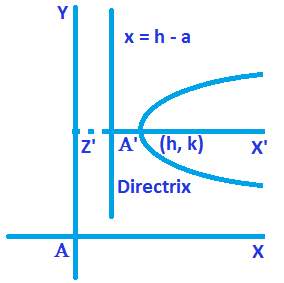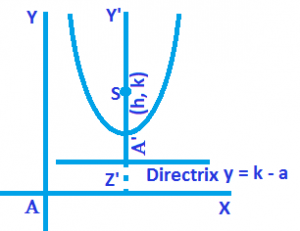Equation of the Parabola when Vertex is (h, k) and Axis is Parallel to X – axis and Y – axis
Equation of the Parabola when Vertex is (h, k) and Axis is Parallel to X – axis:
The parabola y² = 4ax
Can be written as (y – 0)² = 4a(x – 0) … (1)
The vertex of this parabola is A (0, 0)
Now, when the origin is shifted to A’ (h, k) without changing the direction of the axes.
The equation becomes (y – k)² = 4a(x – h) … (2)

This is called the general form of the parabola (1) and axis A’X’ || AX with its vertex at A’ (h, k).
Its focus is at (a + h, k) and the length of latus rectum is 4a.
The equation of the directrix is
x = h – a
x + a – h = 0
Equation of the Parabola when Vertex is (h, k) and Axis is Parallel to Y – axis:
The parabola x² = 4ay
Can be written as (x – 0)² = 4a(y – 0) … (1)
The vertex of this parabola is A (0, 0)
Now, when the origin is shifted to A’ (h, k) without changing the direction of the axes.
The equation becomes (x – h)² = 4a (y – k) … (2)

Its vertex at A’ (h, k).
Its focus is at (h, a + k) and the length of latus rectum is 4a.
The equation of the directrix is
y = k – a
y + a – k = 0
Example: Find the value of p such that the vertex of y = x² + 2px + 13 is 4 units above the x – axis.
Solution: Given parabola is y = x² + 2px + 13
y = (x + p)² – p² + 13
y – (13 -p²) = ( x + p) ²
So, the vertex is (-p, 13-p²)
Since, the parabola is at a distance of 4 units above the x – axis
13 – p² = 4
⇒ p² = 13 – 4
⇒ p² = 9
⇒ p = ± 3.
